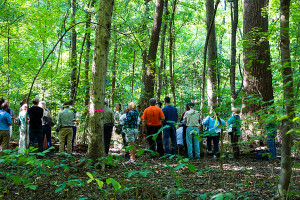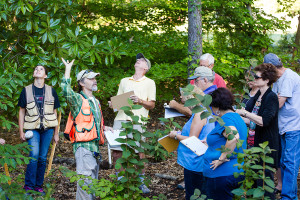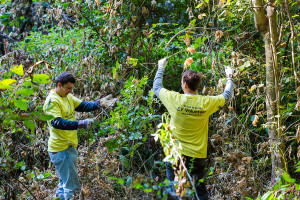What a forest can teach us

Last week, the Tennessee Urban Forestry Conference came to town. “Walking in Memphis: The Future of the Urban Forest” brought professionals from around the state to learn about critical issues facing the urban forest, share solutions and technologies, and develop strategies for a greener future. And as you can imagine, Overton Park was a centerpiece of the program. Our unique resource–an old-growth forest in the middle of a highly-developed urban area–is of great interest when studying human impacts on an ecosystem.
The Old Forest featured in four conference sessions: Dr. Robert Loeb’s plenary discussion about researching old-growth forests, Kyle Simpson’s talk about researching perceptions of forest management, our Director of Operations Eric Bridges’ talk about using technology for research, and a walking tour. The Rhodes College Urban Forestry Fellows demonstrated to the tour group how they use the i-Tree inventory process to collect data about the trees in the woods.
 The i-Tree inventory process was also a key feature of the Urban Forestry Advisor’s Class, held this fall at Memphis Botanic Garden. The course, which is open to the general public, covers tree biology and ID, risk management in urban forestry, site analysis, tree inventory, and the role of government agencies in managing urban forests. Eric and the Rhodes fellows took the class into the field to illustrate the different methods for measuring tree height and diameter, as well as how to record this information in a way that makes it possible to track information over the long term. A key part of urban forestry research is carefully choosing plots to study, mapping them, and recording the data in a way that allows future researchers to measure the same area.
The i-Tree inventory process was also a key feature of the Urban Forestry Advisor’s Class, held this fall at Memphis Botanic Garden. The course, which is open to the general public, covers tree biology and ID, risk management in urban forestry, site analysis, tree inventory, and the role of government agencies in managing urban forests. Eric and the Rhodes fellows took the class into the field to illustrate the different methods for measuring tree height and diameter, as well as how to record this information in a way that makes it possible to track information over the long term. A key part of urban forestry research is carefully choosing plots to study, mapping them, and recording the data in a way that allows future researchers to measure the same area.
 Even our park volunteers are getting into the act, learning about a specific issue in urban forest management: invasive plants. Dozens of volunteers from the local Ernst & Young office came to spruce up the park as part of September’s global corporate volunteer event. While one group painted the railings at Rainbow Lake and another removed litter, Eric brought the most hardcore bunch deep into the woods to attack a patch of kudzu. The volunteers learned a lot about what makes the vine so invasive, such as the fact that “kudzu climbs itself”: when a vine is cut at the ground, if the part hanging from a tree isn’t also cut, the vine resprouts and grabs onto the dead hanging portion, jumping right back into the tree. Armed with both knowledge and sturdy loppers, the volunteers helped remove quite a bit of this highly invasive species from an area where it had been hiding off-trail.
Even our park volunteers are getting into the act, learning about a specific issue in urban forest management: invasive plants. Dozens of volunteers from the local Ernst & Young office came to spruce up the park as part of September’s global corporate volunteer event. While one group painted the railings at Rainbow Lake and another removed litter, Eric brought the most hardcore bunch deep into the woods to attack a patch of kudzu. The volunteers learned a lot about what makes the vine so invasive, such as the fact that “kudzu climbs itself”: when a vine is cut at the ground, if the part hanging from a tree isn’t also cut, the vine resprouts and grabs onto the dead hanging portion, jumping right back into the tree. Armed with both knowledge and sturdy loppers, the volunteers helped remove quite a bit of this highly invasive species from an area where it had been hiding off-trail.



